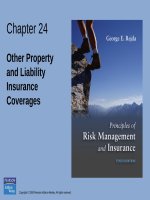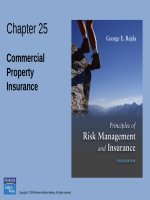Principles of risk management and insurance 12th by rejde mcnamara chapter 22
Bạn đang xem bản rút gọn của tài liệu. Xem và tải ngay bản đầy đủ của tài liệu tại đây (406.96 KB, 29 trang )
Chapter 22
Auto Insurance
Agenda
• Personal Auto Policy
–
–
–
–
–
–
Part
Part
Part
Part
Part
Part
A: Liability Coverage
B: Medical Payments Coverage
C: Uninsured Motorists Coverage
D: Coverage for Damage to Your Auto
E: Duties After an Accident or Loss
F: General Provisions
• Insuring Motorcycles and Other Vehicles
Copyright ©2014 Pearson Education, Inc. All rights reserved.
22-2
Personal Auto Policy Basics
• The 2005 Personal Auto Policy (PAP) is
widely used throughout the US
– Drafted by the ISO, it replaces the 1998 form
• Eligible vehicles include:
– A four-wheeled motor vehicle owned or leased
by the insured for at least six consecutive
months
– A pick-up or van with a gross vehicle weight
rating of 10,000 pounds or less
Copyright ©2014 Pearson Education, Inc. All rights reserved.
22-3
Personal Auto Policy Basics
• Autos covered by the policy include:
– Any auto shown in the declarations
– A newly acquired auto
– A trailer owned by the named insured
– A temporary substitute vehicle, which is a
nonowned auto or trailer used temporarily
because of mechanical breakdown, repair,
servicing, loss, or destruction of a covered
vehicle
Copyright ©2014 Pearson Education, Inc. All rights reserved.
22-4
Part A: Liability Coverage
• Liability coverage (Part A) is the most important
part of the PAP
– It protects a covered person against a suit or claim arising
out of the ownership or operation of a covered vehicle
– The coverage is usually written in split limits, where the
amounts of insurance for bodily injury liability and property
damage liability are stated separately
– Split limits of 250/500/100 mean that you have bodily
injury coverage of $250,000 for each person, a maximum
of $500,000 of bodily injury coverage per accident, and a
maximum of $100,000 for property damage liability
Copyright ©2014 Pearson Education, Inc. All rights reserved.
22-5
Part A: Liability Coverage
• Liability coverage applies to:
– The named insured and any resident family
member
– Any person using the named insured’s covered
auto
– Any person or organization legally responsible
for any insured’s use of a covered auto on behalf
of that person or organization
– Any person or organization legally responsible
for the named insured’s or family members’ use
of any auto or trailer (other than a covered auto
or one owned by the person or organization)
Copyright ©2014 Pearson Education, Inc. All rights reserved.
22-6
Part A: Liability Coverage
• The insurer also agrees to provide defense
and pay all legal defense costs for claims
covered by the policy
• The policy also allows for certain
supplementary payments including:
–
–
–
–
–
The cost of a bail bond
Premiums on appeals bonds
Interest accruing after a judgment
Loss of earnings ($200/day)
Other reasonable expenses
Copyright ©2014 Pearson Education, Inc. All rights reserved.
22-7
Part A: Liability Coverage
• Exclusions to the coverage include:
–
–
–
–
–
–
–
–
Intentional injury or damage
Property owned or transported
Property rented, used, or in the insured’s care
Bodily injury to an employee
Use as a public livery or conveyance
Vehicles used in the auto business
Vehicles with fewer than four wheels
Vehicle furnished for the insured’s regular use
Copyright ©2014 Pearson Education, Inc. All rights reserved.
22-8
Part A: Liability Coverage
• If an accident occurs in another state, and
the financial responsibility law in that state
has higher liability limits than shown in the
declarations, the PAP automatically provides
the higher limits
• If more than one liability policy covers a loss:
– The insurer pays its pro rata share of the loss for
an owned vehicle
– The insurance coverage is excess over any other
insurance for a nonowned vehicle
Copyright ©2014 Pearson Education, Inc. All rights reserved.
22-9
Exhibit 22.1 Primary and Excess Insurance
Copyright ©2014 Pearson Education, Inc. All rights reserved.
22-10
Part B: Medical Payments
• Medical payments coverage covers all reasonable
medical and funeral expenses incurred by an insured
in an accident
• The named insured and family members are covered:
– While occupying any motor vehicle, or
– As pedestrians when struck by a motor vehicle
• Other persons occupying a covered auto are covered
– But not covered in a nonowned vehicle
• Covers medical services rendered within three years
from the date of the accident
• Coverage is not based on fault
Copyright ©2014 Pearson Education, Inc. All rights reserved.
22-11
Part B: Medical Payments
• Exclusions to the coverage include injuries
sustained:
– While occupying a vehicle with fewer than four
wheels
– While operating the vehicle as a public livery or
conveyance
– When the vehicle is used as a residence
– When the vehicle is used without a reasonable
belief of permission
– When the vehicle is competing in a race
Copyright ©2014 Pearson Education, Inc. All rights reserved.
22-12
Part B: Medical Payments
• If more than one auto policy covers a loss:
– The insurer pays its pro rata share of the loss for
an owned vehicle
– The insurance coverage is excess over any other
insurance for a nonowned vehicle
Copyright ©2014 Pearson Education, Inc. All rights reserved.
22-13
Part C: Uninsured Motorists
Coverage
• Uninsured motorists coverage pays for the
bodily injury caused by an uninsured
motorist, by a hit-and-run driver, or by a
negligent driver whose insurance company
is insolvent
– In some states, property damage is also covered
– The uninsured motorist must be legally liable
Copyright ©2014 Pearson Education, Inc. All rights reserved.
22-14
Part C: Uninsured Motorists
Coverage
• The coverage applies to:
– The named insured and family members
– Another person while occupying a covered auto
– Any person legally entitled to recover damages
• Coverage does not apply when:
– An insured is injured in, or by, a vehicle owned by
the named insured, but not insured under the
policy
– There is primary coverage under another policy
– The vehicle is used as a public livery or
conveyance
– When workers compensation benefits are
applicable
Copyright ©2014 Pearson Education, Inc. All rights reserved.
22-15
Exhibit 22.2 Estimated Percentage of Uninsured Motorists
in the United States in 2009
Copyright ©2014 Pearson Education, Inc. All rights reserved.
22-16
Part C: Uninsured Motorists
Coverage
• There are several limitations when more
than one uninsured motorist coverage
provision applies to a loss
– For example, if an insurer provides coverage on a
vehicle not owned by the named insured, the
insurance provided is excess over any collectible
insurance provided on a primary basis
Copyright ©2014 Pearson Education, Inc. All rights reserved.
22-17
Part C: Uninsured Motorists Coverage
• Underinsured motorists coverage can be
added to the PAP to provide more complete
protection
– In general, the maximum amount paid is the
underinsured motorist’s coverage limit stated in
the policy less the amount paid by the negligent
driver’s insurer
– Coverage is typically added as an endorsement
– Some states make coverage mandatory, while
others make it optional
Copyright ©2014 Pearson Education, Inc. All rights reserved.
22-18
Part D: Coverage for Damage to
Your Auto
• Under the coverage for damage to your
auto, the insurer agrees to pay for any
direct and accidental loss to a covered auto
or any nonowned auto
• A collision is defined as the upset of your
covered auto or nonowned auto or its
impact with another vehicle or object
• Collision losses are paid regardless of fault
Copyright ©2014 Pearson Education, Inc. All rights reserved.
22-19
Part D: Coverage for Damage to
Your Auto
• An other-than-collision loss is a loss due to
the following perils:
• Missiles or falling objects
• Hail, water, flood, fire, windstorm
• Riot or civil commotion
• Malicious mischief or vandalism
• Contact with a bird or animal
• Theft
• Glass breakage
• Explosion or earthquake
Copyright ©2014 Pearson Education, Inc. All rights reserved.
22-20
Part D: Coverage for Damage to
Your Auto
• A nonowned auto is also covered under the
Part D coverages
– A nonowned auto is a private passenger auto,
pickup, van, or trailer not owned by or furnished
or made available for regular use of the named
insured or family member, while it is in the
custody of or being operated by the named
insured or family member
– The coverage also applies to a temporary
substitute vehicle
• A collision damage waiver (CDW) may be
unnecessary on a rental car if you carry
collision and comprehensive coverage on
your own car
Copyright ©2014 Pearson Education, Inc. All rights reserved.
22-21
Part D: Coverage for Damage to
Your Auto
• Part D also pays for temporary
transportation expenses, e.g., for train, bus,
taxi expenses
– The expense must be the result of a covered loss
– Coverage is subject to a daily and total limit
– Includes charges from a rental car company for
loss of daily rental
– Coverage for towing and labor costs can be
added by an endorsement
Copyright ©2014 Pearson Education, Inc. All rights reserved.
22-22
Part D: Coverage for Damage to
Your Auto
• Exclusions to the coverage include:
– Use as a public livery or conveyance
– Damage from wear and tear, freezing, and
mechanical or electrical breakdown
– Radioactive contamination or war
– Certain electronic equipment
– Tapes, records, and disks
– Government destruction or confiscation
– Trailer, camper body, or motor home
– Racing vehicle
Copyright ©2014 Pearson Education, Inc. All rights reserved.
22-23
Part D: Coverage for Damage to
Your Auto
• For a total loss, the policy pays the actual
cash value less the deductible
• For a partial loss, the policy pays only the
amount necessary to repair or replace the
damaged property of like kind and quality
• Insurers can add a clarifying endorsement
to exclude coverage for diminution in value
from a direct and accidental physical
damage loss
– The insured can also purchase gap insurance
Copyright ©2014 Pearson Education, Inc. All rights reserved.
22-24
Part D: Coverage for Damage to
Your Auto
• If more than one auto policy covers a
physical damage loss:
– The insurer pays its pro rata share of the loss for
an owned vehicle
– The insurance coverage is excess over any other
insurance for a nonowned vehicle
• The policy includes an appraisal provision
for handling disputes over the amount of
physical damage loss
– Either party can demand an appraisal of the loss
Copyright ©2014 Pearson Education, Inc. All rights reserved.
22-25









